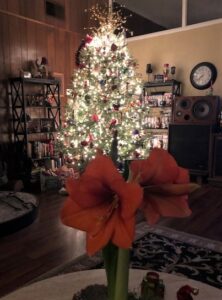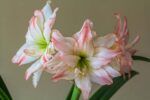
While the amaryllis doesn’t literally sing, it is majestic and calls out or “harks” to listen up, look at me and my showy trumpets in bloom! Second to the poinsettia, amaryllis is one of the most popular Christmas flowers.
The genus name Amaryllis comes from the Greek word “amarysso,” which means “to sparkle.” In Greek mythology, it was the name of a shepherdess who shed her own blood to prove her true love which inspired the naming of this bright red flower. And the long stems, strapping leaves, and sparkling trumpet-shaped flowers which tower above definitely provide a stunning centerpiece in any room during the holidays.
 I hadn’t bought an amaryllis bulb or a plant already in bloom for the holidays in several years. Last year, I wanted to change up what I normally use as the centerpiece on my living room coffee table so instead of a red poinsettia, I found a great deal on a red amaryllis. I bought it about three weeks before Christmas. It had several buds but wasn’t yet in bloom. When it did open, it provided just the right amount of “sparkle.”
I hadn’t bought an amaryllis bulb or a plant already in bloom for the holidays in several years. Last year, I wanted to change up what I normally use as the centerpiece on my living room coffee table so instead of a red poinsettia, I found a great deal on a red amaryllis. I bought it about three weeks before Christmas. It had several buds but wasn’t yet in bloom. When it did open, it provided just the right amount of “sparkle.”
The care for amaryllis is much like any houseplant.
- Water the plant when the top 2 inches of soil feels dry, allowing the container to drain freely each time.
- Do not let the plant sit in water as wet soil can promote bulb and root rot and attract pests.
Getting the amaryllis to rebloom
There are actually two different types of amaryllis -the ones we buy for indoor Christmas displays, the genus Hippeastrum, and the Amaryllis belladonna, which is strictly a garden plant. Although the Hippeastrums also can be used as perennials in zones 9 through 11, blooming in spring there, most of us grow them indoors during winter.
The hard part usually isn’t getting them to bloom, which most of the houseplant ones will do reliably about 6 to 8 weeks after they are planted, but keeping them healthy enough that they will flower again the following winter can be more tricky.
After the flowers fade and the strappy leaves begin to appear, cut the flower stalks off a couple inches above the bulb and treat the amaryllis as you would any other light-loving houseplant. Although some sources recommend fertilizing it about every two weeks at this stage, you’ll probably want to reduce the strength of the plant food you use or wait until spring, since winter feeding tends to encourage the sort of soft growth which causes insect infestations.
You’ll need the bulb to make at least four large leaves to have any hope of blooming again the following winter. During the summer, you can move it outdoors, placing it in a shady location first and gradually moving it out into the sun. However, if you purchased an already potted bulb, determine whether the pot has drainage holes before you take it outside. If it doesn’t, you should make some or transfer the bulb to another container. I’ve learned from bitter experience that a pot without holes can gather too much water from rainfall and rot the bulb.
The big sleep
In autumn move the plant to a cool, dark place and stop watering it until the foliage withers. The preferred temperature during this period is 50 to 55 degrees Fahrenheit. Although directions usually specify that the bulb should remain dormant for two to three months, it often will try to “rise and shine” in six weeks or less if its temperature is warmer than the recommended one. When you see a bud starting, bring the plant out to your windowsill or grow light and begin watering it again. Should the amaryllis seem to be “sleeping well,” though, you can let it rest for a couple months and attempt to rouse it with warmth, water, and light six to eight weeks before the date when you would like it to bloom. If you need to repot your bulb, do so just as it is beginning to emerge from dormancy.
Although my amaryllis of choice for the holidays is red, amaryllis come in a variety of colors. Choose whatever works for where you will be displaying it.
Here are some interesting facts about these “stunners.”
- A common name for the amaryllis is the “naked lady,” because the flowers grow first and then the leaves, making the blossoms look “naked” before the leaves appear.
- The amaryllis can grow both indoors and outdoors, and more than 10 million of these bulbs are sold throughout the world every year.
- The bulbs can regrow flowers year after year for up to 75 years.
- There are parts of the amaryllis plant that have been removed and used in medications to treat Alzheimer’s.
- The flowers of the amaryllis attract moths and carpenter bees, which are responsible for the plant’s pollination.
Are you using amaryllis for your Christmas displays? Send pictures. We’d love to see them.







